David R. Cheriton School of Computer Science 50th Anniversary
Women in Computing
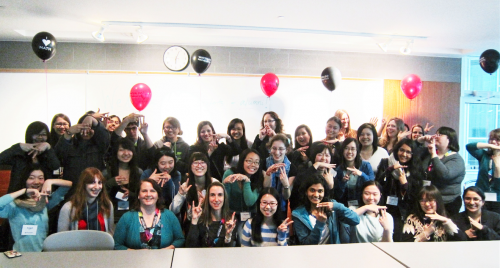
There’s a very good reason why Jo Atlee decided to teach Computer Science at the University of Waterloo after completing her PhD.
She was looking for an academic position in 1992 and had a number of interviews at various institutions, but there was something about Waterloo that stood out.
“Everywhere else I interviewed, I would have been the first or the second woman in the department. Here, I was the fifth,” she said. “I didn’t think there was going to be any issues of gender equity.”
And gender equity is something that’s important to Atlee, who is the Director of Women in Computer Science within the David R. Cheriton School of Computer Science.
Women in Computer Science (WiCS) is an initiative that turns 10 years old this year as the School celebrates its own milestone anniversary – 50 years. The School and the Faculty of Mathematics launched WICS in 2007 as an extension of an earlier initiative, Women in Mathematics, after recognizing a serious issue.
Atlee and her colleagues realized that if Computer Science were taken out of the equation, the ratio of females to males in Mathematics at Waterloo was almost 1:1. That was certainly not the case in Computer Science, where the percentage of female students hovered at only 10 to 15 per cent.
“CS kind of recognized that they had a much more severe problem and they needed to take more aggressive actions, which is why WiCS was formed,” Atlee said.
The mandate of WiCS has been to help female computer science students feel supported and confident.
Atlee explained that first-year male students generally have a slight edge in this field. Male students are likely to have played more, taken more courses in high school, and are more likely to have participated in computing camps.
“But it’s not a gap that can’t be overcome,” Atlee said. “I tend to think of computing as being analogous to learning a musical instrument. A lot of the exposure that kids in K-12 tend to get is the kind you get in music camps – let’s go and play songs, or maybe they’ll pick up a guitar and play chords and learn how to play songs. But that’s not the same thing as getting a grounded education in music theory and how to really master a musical instrument.”
A similar grounded education in computing is what’s offered at Waterloo. That enables women to close the gap between them and their male peers.
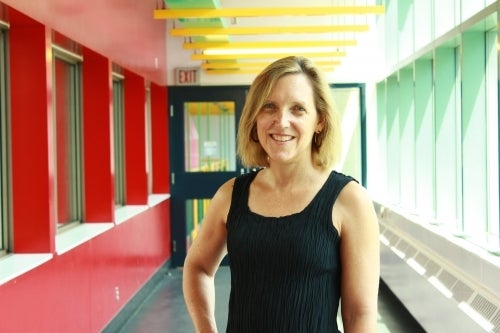
“Part of what we try to do with WiCS is explain to female students who aren’t getting A’s that they’re still really good computer scientists and they should stay in the program,” Atlee said, remembering her own youth as a mathematician and computer scientist, when sometimes she was the best in class, and sometimes she wasn’t.
“I was best often enough that I never questioned my abilities, and nobody else questioned my abilities, whereas women who go through as B or C students are more likely to see those challenges.”
“There’s confidence issues like you’ll find with any minority. There’s also lost networking opportunities, so they don’t quite have the same opportunities as a majority group,” agreed Kate Larson, an associate professor in the Cheriton School of Computer Science.
“I think it’s tiring to be one of very few. That’d be true of any gender, or really any minority, I would imagine.”
It’s important for the members of WiCS to serve as positive female role models for students, because people like Atlee and Larson didn’t necessarily have that when they were younger.
For Atlee, her strongest influence was probably her mother.
“There weren’t computers just lying around when I was growing up. The PC came out just as I was leaving high school,” Atlee said. “All computing before then was on a mainframe, and there wasn’t necessarily easy access to mainframes. So most people, when they got to university, had no computing experience at all. So there I took a course, because my mother insisted I take a course – my father worked for IBM – so she insisted I take a computing course. And I liked it. That’s about the extent of how I ended up getting into computing.”
Atlee completed a BSc in Computer Science and Physics at the College of William and Mary in Williamsburg, VA, before going on to graduate school at the University of Maryland in College Park, MD, where she earned her master’s degree and her doctorate. She can basically trace it all back to her mother’s insistence.
“She saw my father, he had a very successful career at IBM, and she knew that I was mathematically inclined,” Atlee said. “Math tends to be this abstract concept that you study in school – what are you going to do with a math degree? What are you going to do with a physics degree? She understood, unlike many people, what one could do with a computing degree.”
Larson was a bit luckier in that she had two strong female role models in university. The first was Sherry Mantyka, a professor in the Department of Mathematics and Statistics at Memorial University in St. John’s, NL, where Larson earned her BSc in pure mathematics. Coincidentally, Mantyka is an alumna from Waterloo (MMath ’70, PhD ’73).
“She really pushed me hard. She was my main cheerleader, saying, yes, you have to go off to grad school, yes, you should take all the advanced courses,” Larson said. “She was very important and very supportive.”
After completing her master’s at Washington University in St. Louis, MO, Larson did her PhD at Carnegie Mellon University in Pittsburgh, PA. She was mentored there by computer science professor Manuela Veloso.
“She continues to this day to be very, very supportive. She’s been somebody else who’s pushed when I’ve needed a shove,” Larson said, adding she’s been fortunate to have both of these women in her life.
“They were the ones that, whenever I had any self doubt, would kick me a little bit and say, oh, nonsense, or, grab that opportunity, don’t take a step backward.”
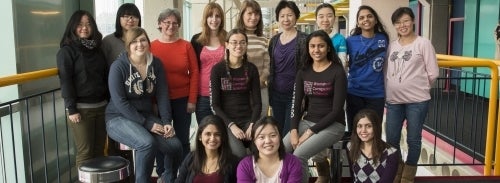
Sandy Graham’s experience is like Atlee’s in that she came of age at a time when computer science wasn’t clearly understood by a lot of people. She began her undergraduate degree at Waterloo in 1985 and graduated with a BMath in Computer Science in 1990.
“We didn’t really know what it meant to be in Computer Science at that time, because there weren’t a lot of role models, period,” said Graham, who is now a lecturer in Mathematics at UWaterloo. “I had no female role models in computing, except to say that some of my peers were females in Computer Science as well.”
That was in the late 1980s, when the percentage of women in Computer Science at Waterloo was at an all-time high.
“I believe that a lot of that had to do with the fact that the stereotypes weren’t really established at that point, because nobody had any idea what it meant to be in Computer Science,” she said. “The stereotypes were developed subsequent to that time, or during that time.”
The theory is that the first personal computers were marketed as a thing for boys, rather than girls. Boys were seen as being more interested in electronics, so that’s where the push was.
“And then when they appeared in the schools, there were so few of them that they tended to be dominantly used by boys,” Atlee said. “So back in the ‘90s, and even in the late ‘80s a little bit, there was a much bigger gap in experience level between boys and girls entering university.
“Any technically inclined woman is going to say, ‘I can’t compete with these guys, I’ll go to a different technical field where the playing field is a little more even.’”
For women who were already studying in the field when the stereotypes started to become entrenched, the change was sudden and obvious.
“I do remember very clearly walking into a third-year course, a class that holds 60 people, I guess,” Graham said. “The class was filling up, and I saw one other female student in the class when I walked in. That was the first time that I looked around and noticed, really noticed, that I was a minority there. That was a big eye-opener for me.”
Dan Brown, the Cheriton School’s Director of Undergraduate Studies, said the computing industry is still coping with the effects of those stereotypes today.
“That predominance of men has frankly been really negative for the industry in a lot of different ways,” he said. “The computing industry makes these products that routinely embody a lot of sexism and don’t even realize it, and every week there’s another story about what’s going on at a major tech company around some pretty nasty consequences of that sort of structural sexism.”
When Graham returned to Waterloo as a lecturer in 1998, after several years of teaching high school, it was with the intent of joining the Centre for Education in Mathematics and Computing and participating in outreach programs designed to attract high school students – particularly female students – to Waterloo.
In her role with the CEMC, Graham, who now also has a master’s degree from Waterloo, works to promote computer science through workshops specifically aimed at female students. One workshop is a day-long activity for Grade 10 girls who are introduced to programming through a language called Alice.
“I do a week-long workshop for high school girls in Grade 9 and 10. They apply and come from across Canada to stay on campus for a week, and we try to spark their interest – the idea being that they have little or no experience in computer science. Hopefully after a week they would consider computer science as a field to study, both in high school and in university.”
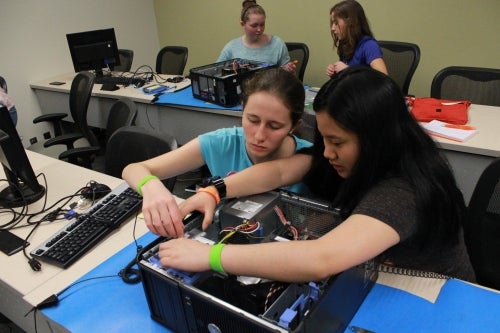
The students learn during their week on campus that there’s a lot more to the discipline than software and programming. One practical skill they are taught, for example, is how to take computers apart and put them back together again. They are also introduced to professors and other students, and the level of social interaction can help to dispel negative myths and misconceptions about computing.
“The emphasis is to try to provide them with a breadth of experience in terms of what computer science can be,” Graham said. “We give them everything from a little bit of theory to applications like bioinformatics or human-computer interaction.”
This is a popular event that attracts more than 10 times as many applicants as the workshop can accommodate. It’s an expensive program too, because most of the costs, including travel and accommodations, are covered by the CEMC.
Funding is made possible by support from the J.W. Graham Endowment Fund and a grant from the Bill and Melinda Gates Foundation. The workshop was deemed a worthy endeavour because of the disparity between female and male applicants to Computer Science at Waterloo.
“We couldn’t do it otherwise,” Graham said of the funding. “We didn’t want any barriers to be there for people who would benefit from the experience but not have the means to attend.”
Once students get to Waterloo, the emphasis is on convincing them to stay. WiCS plays an important role in that.
“If they leave CS because they find another passion, that’s great, but we don’t want them leaving CS because of unnatural obstacles to success,” Atlee said, noting that the University is aware that discrimination toward female computing students still exists, particularly in co-op jobs off campus. Supports are designed to raise awareness of ongoing issues, and manage expectations.
“If they go into the workplace and someone says something that’s inappropriate, they need to recognize that it’s inappropriate and not think, is there something they did to bring this on? Is it maybe that they don’t fit into the culture?” she said. “The problem is with the culture, not with them.
“A lot of it is awareness raising, and some of it is just survival skills – you’re about to go out into a male-dominated workplace, and how to do that in a way that you succeed, and recognize when you need to leave. But leave the workplace, don’t leave the discipline.”
Larson says the WiCS undergraduate committee goes above and beyond with its own efforts, in terms of both reaching out to prospective students and ensuring that current students know that they have a supportive environment.
“They seem to have this vibrant group. They’re running tons of workshops and different activities, both on the technical and the social side. They seem to be developing a really strong community,” Larson said. “You have peers, and you’re not alone.”
The work is having a positive effect, as the Cheriton School of Computer Science has enjoyed an increase in female enrollment in recent years.
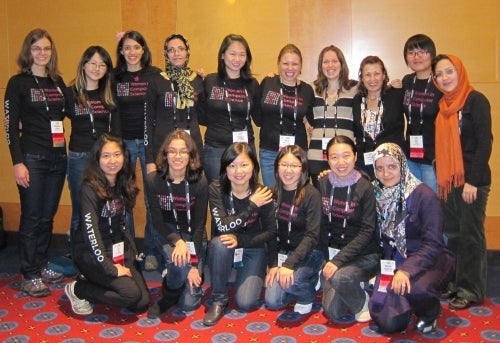
“The percentage of women in CS coming in over the last three years has gone from 15 per cent to 25 per cent,” said Mark Giesbrecht, Director of the Cheriton School. “I don’t think we can take credit for all of it, but I think the overall work that’s being done is huge.
“And there’s still a long way to go; that’s 25 per cent, not 50 per cent. It’s moving in the right direction, and we have to acknowledge that this is going to be a big effort all the way along.”
As part of that commitment, Giesbrecht added, the Director of Women in Computer Science is a member of the School’s Executive Committee.
“That means you get high-level input from that perspective on every decision the School makes,” he said. “This allows us to check everything against how we’ve been doing it, and how we should be doing it.”
Atlee said with pride that enrollment increases similar to Waterloo’s are also happening in other institutions across North America.
“The gap is much narrower and there are many more concerted efforts to promote women in computing,” she said.
She believes that because computers and electronic devices are so ubiquitous now, it’s easier for females to see themselves in the discipline than it was 25 or 30 years ago.
“Everybody has a smartphone, and the uses of computing are much more centred around social media rather than games, and so you can have as much or even more use of computers by girls than by boys.”
“Boys and girls are both growing up as digital natives,” Brown agreed. “It’s actually maybe a little easier for us to start marketing computer science to young men and to young women.”
While efforts at gender equity continue, women already in computing at Waterloo are making great strides. For instance, Larson was honoured last year when the Canadian Association of Computer Science named her an Outstanding Young Computer Science Researcher.
The honour recognizes excellence by a researcher within 10 years of finishing their PhD, and Larson was the fourth professor – and first female professor – from the Cheriton School of Computer Science to have won this prize since it was first awarded in 2009.
Larson is proud of the award, and she credits Waterloo with giving her the freedom and encouragement to pursue her own research interests. In that way, she said, the prize is a reflection on the University.
Going forward, efforts will continue to reach out to prospective students and let them know of the opportunities that exist in the field.
“There’s so many different reasons to like computer science,” Graham said, pointing out that students can learn invaluable problem-solving skills that are practical even in fields unrelated to math or engineering.




